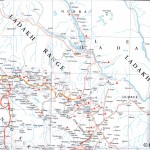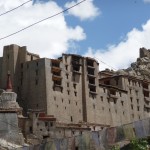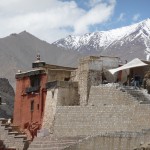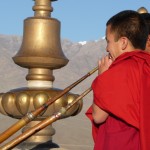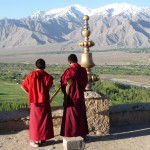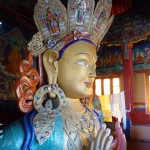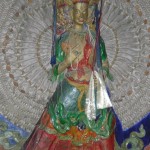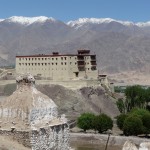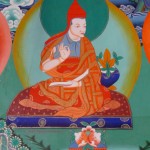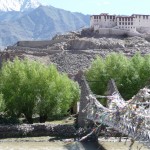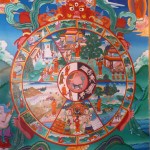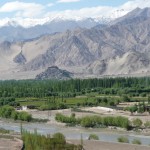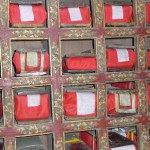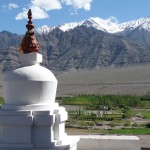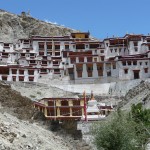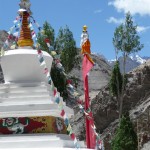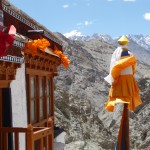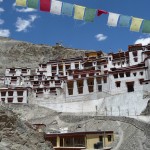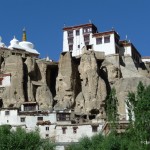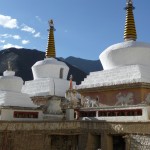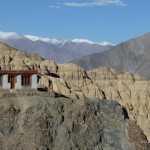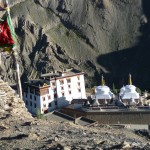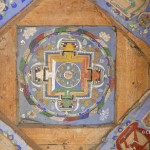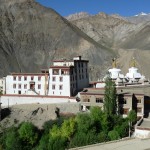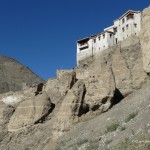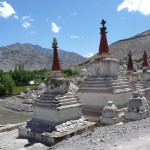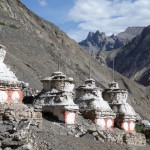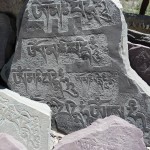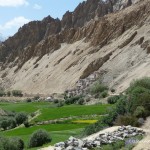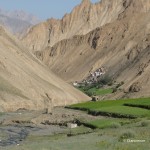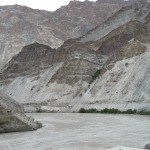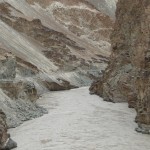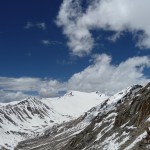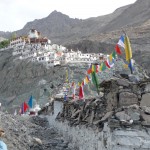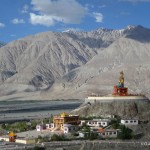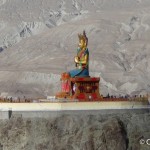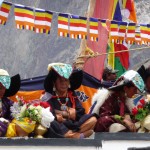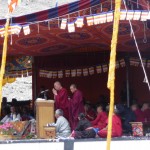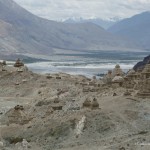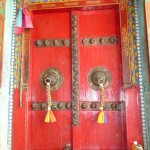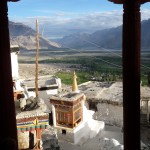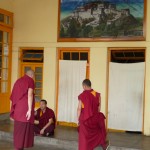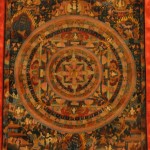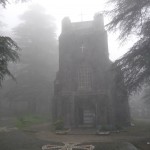It was during a trip in the summer of 2010 in Ladakh, in northern India and the Himalayan Mountains that it became obvious to me that I needed to talk about the sacred mountains after my return.
I was with my friend Yves who had just recovered from a disease and his wife Anne-Marie. I was brought to think about spirituality for the first time. During the trip, I visited a number of Buddhist monasteries in the area of Leh (capital of Ladakh), I trekked with a local guide, a chef muleteer and a cook during 6 days from Indus to Zanskar and then to Leh after that to Lamayuru and up to Chiling before coming back to Leh. And after making our way through those spectacular territories, the mountains when driving up the pass of Khardungla (the highest pass accessible to motor vehicles in the world – 5606 m) we arrived in the valley of Nubra. I took part in an intense spiritual moment, deeply emotional, when the Dalaï Lama in person inaugurated the largest Bouddha in the world, recently built at the borders of India, China and Pakistan next to the monastery of Diskitt. Then we stopped at Dharamsala, headquarters of the Tibetan government in exile, home of a great number of monasteries and the residence of the Dalaï Lama. We visited several monasteries, but also the protestant church of Saint John’s which is a classified historical building in India and symbol of the English presence, and then we came back to Delhi.
At this time already, my soul, my spirit had vibrated repeatedly, inviting me to think and meditate in this area where I had lived in the past my most vivid emotions:
- In 1994 when I climbed the glacier of Baltoro, towards the Camp base and N°1 of K2, Hiden Peak, the ascent of the Gondogoro peak… one of the largest glacier in the world, in the north-east of Pakistan neighboring Kashmir of which Ladhak is part of, a border that is disputed between China, India and Pakistan, I had this natural, spectacular and memorable sight
- In 1997 further east in the Himalayan mountains when I ascended the 8201m-high Cho-Oyu leaving from Katmandu Nepal towards Tingri in Tibet, the starting point of the ascents of the Everest and the CHO OYU, where near the summit at about 8100 m without supplementary oxygen, my spirit left my body… and I spoke with my father…before I flew back over Cairo in Egypt where my father disappeared…
The challenge
Tasking up challenges has always come to me naturally and enabled me to move forward whether intellectually or physically, for personal or professional causes: it brings satisfaction to surpass one self and to go beyond one’s limits and it provides an experience on which one can rely on, and a self-confidence we all need.
I have always been yomping around ever since I can remember but unfortunately, at the age of sixty, my knees reminded me that I no longer had the laxity of my twenties! While I was out ski-touring the Big Crossing of the Alps in April of 2010, I fell and tore my cruciate ligaments on both of my knees.
It was crucial for me to overcome this ordeal in order to be able keep on hiking and to keep on exploring the mountains and the world and to stay motivated.
I then undertook rather mindlessly a work-out program that consisted in cycling kilometers on my exercise bike, a bike trek Olivet-Toulon (840km) at a rate of 120 km a day, only to drop by and kiss my mother. Since then I take care of myself to stay fit, either by biking to my job in Montreuil, or in the Orleans area where I live, or by meeting up once a week with a bunch of friends for a 60km ride in the Sologne, and otherwise taking every possible opportunity to go for a walk, especially in Paris…
Bouddhist Prayer in the monastery of Thikse Ladakh
Let’s go back to the trip, which I described only briefly at the beginning of this comment. We flew over the Himalayan Mountains from New Dehli, in India at the Pakistani and Chinese borders we are greeted by our guide Rigzin at the airport of Leh 3500 m up in the mountains. The landing was intense, because the meteorological conditions obliged the pilot to circle for about 45 minutes above the ’Indus river and the Stok Kangi Range. The view from our window was fantastic, we are flying above glaciers, mountains; when arriving in Leh we could see green strips of cultivated land in a largely mineral environment. Our guide brings us to our Lodge, Padma Guest-house. We walked through the traditional shopping street, then climb rapidly up the town and visited the monastery and of the Palace of Leh recently renovated: miniature version of Potala in Lhasa.
We find our self in Ladakh (also called “Little Tibet”) an area of Kashmir. This particularly dry area, where flows the Indus; it is cultivated only where the rivers hurtle down the hills who are coming from the glaciers and are being used for irrigation. The villages from the neighboring valleys are connected via passes 4000 m to 5600 m high… In contrast to Tibet (today under Chinese administration) which stayed withdrawn, Ladakh (under Indian administration), given its geographical sight, a crossroads for several different cultures, is welcoming,… inhabited by a joyful population.
It is an area similar to Tibet, but also different due to the presence of Ladakhis Muslims, Christians, and soldiers of the Indian army. There are numerous monasteries; walls with engraved stones, chortens, stupas, prayer flags enwrapping bridges and other places that characterize Tibetan Buddhism. Chortens are tombs where are deposited the ashes of the deceased, composed of 5 elements placed on top of each other. From the bottom part to the summit there is an evolution from the rough to the refined, by analogy to the spiritual process that brings the ordinary human being to enlightenment (Buddha). The square base represents earth, the round dome water, the triangular spire fire, the parasol the air and the sun, the moon ether the subtle…
We call a taxi in order to leave early in the morning on July 15th, 2010 and to take part at the prayer of the monastery of Thikse.
The monasteries ensure the religious function, but also elementary education, clinics for health care… We can see Lamas, but also new novices 7 or 8 years old evolving in the monastery. “It is only up to us to take part at enlightenment, at knowledge, love and compassion, rather than at egocentricity, hatred and confusion” explains us the great Tibetan master Dilgo Khyentse Rinpoche. For the Buddist, all existence no matter which, is very precious: every living being conceals the potential of achieving perfect enlightenment, the state of Buddha during its current or future life. Buddha didn’t give up believing in the genuinely good in a human life, but who would wish suffering. After a long process, of discovering, he teaches the Four Noble Truths: the truth of suffering, the causes of suffering, the end of suffering, and of the road that leads to the end of it… p68 Himalayan Buddhist from Matthieu Ricard.
Visiting monasteries doesn’t leave indifferent, just like visiting a church. The respect of the place, reverence is essential. Artistic expressions such as paintings, draperies, rugs, sculptures, hand-painted furniture… are here numerous, the colors are lively, particularly the color red (perception), yellow (shape), green (mental training), white (sensation and conscience) do come back regularly; the expression tends to be naïve. One takes systematically one’s shoes off at the entrance of a cult. A big Buddha dominates, opposite of it are low seats where the lamas take place for meditation, prayer that is conducted by a superior. There are at least about twenty young Lamas and all generations are represented. The beginning of the prayer is emphasized by the call from the balcony of the monastery with traditional instruments; they use several instruments punctuating their tale by a cymbal or a small bell sound, or a trumpet, a prayer wheel. Sounds are low and the light is diffuse, emotion touches us through “Om Mani Padme Hum” and other Mantra. Lamas have their own reading books of sacred texts. Yves, Anne-Marie and I we are concentrated, are carried away into nobility where reflection, meditation and spirituality touches, sizes us. We feel good, it is fulfillment… we are seated, legs folded in front of us. At the end of the prayer, we look of the breathtaking view from the terrace precisely the place where the Lamas had made their call from, for the prayer by blowing in their long curved instrument creating a low sound and an intense emotion. The valley of the Indus below is lined by snow-capped mountains of 6000 m or more at the end of the horizon… We rent two scooters to visit the monasteries of Stok and Stakna. All monasteries have recently been renovated and enhanced (thanks to the support of western foundations) knowingly the architectural aspects of the building in these spectacular landscapes as well as the quality of the religious and other artworks inside these places of worship.
I would also like to describe our 6 days trek from Lamayuru to Chiling to Zanskar, and our unforgettable journey on July 25th , 2010, the inauguration day of the largest Buddha in Diskitt in the Nubra valley, the warm water springs, the monastery of Ensa and Sumur… and then our return to Delhi to leave again by bus at a distance of 700 km heading further north, to the Himalayans at Dharamsala, headquarters of the Tibetan government in exile and residence of the Dalaï Lama… and where one can find important monasteries such as Karmapa, are so many remarks to share…
I invite you to look at the photographs representing Leh and its surroundings, the different monasteries that we visited particularly Thikse, Stok; Stakna, Rizong and Lamayuru, the departure of our trek with our mules, Chiling and the river Zanskar, the Nubra valley, the inauguration of the Buddha opposite the monastery of Diskitt, and finally the church of Saint John’s in Dharamsala, a gothic, Anglican church.
The Dalaï Lama was asked: What surprises you the most in humanity?, and he answered: “Mankind … Because they are losing health in accumulating money, then they are losing money in regaining health. And while thinking anxiously about the future, they forget the present; they end up living neither in the present nor in the future. They are living as if they would never die and they are dying as if they had never lived.”
The essence of Buddhism, is both to be wise and being compassionate. Being wise allows us to know our uttermost human nature, and compassion gives us to understand that the fulfillment and the suffering of others are more important than our own. I recommend you the wonderful book Himalayan Buddhist mentioned earlier, enlivened by the wonderful photographs of Föllmi.
My intention brought me in this area of the world, particularly on the Mont Kailash and to Bodhagaya, the very place where the XIV Dalaï Lama taught compassion to millions of pilgrims many of which were westerns. He concludes each of his teachings by:
“For as long as space endures,
and for as long as living beings remain,
until then may I too abide
to dispel the misery of the world.”
We are in the center of our own life “The Sacred Mountains” where monasteries are overlooking the valleys, surrounded by high mountains that are leading us indeed to physical and spiritual elevation. Even if we don’t understand the prayers, it is the environment of the mountains, the altitude, the atmosphere, and the emotions, which size our brain and our heart and bring about vivid emotions…
Especially as the Buddhist teachings invite us, nonetheless without blaming us, heading towards more virtuous and positive ways of wisdom and compassion…
- Ladakh – Leh map
- Leh castle
- Leh Monastory
- call to prayer
- Lama
- Divinity
- Divinity
- Monastory Stakna
- divinity
- Monastory Stakna
- Mandala
- Monastory Thiksé
- Prayer book
- Monastory Thiksé
- Monastory Rizong
- Monastory Rizong
- Monastory Rizong
- Monastory Rizong
- Monastory Lamayuru
- Monastory Lamayuru
- Monastory Lamayuru
- Monastory Lamayuru
- Mandala under an arch, Lamayuru
- Lamayuru monastory
- Lamayuru monastory
- chorten
- Chorten Lamayuru monastory
- engraved stone
- Wanla valley
- Wanla valley
- Zanskar river
- Zanskar river
- Khardung pass
- Diskitt Monastory
- Bouddha Diskitt
- Bouddha Diskitt
- Stupa Diskitt
- Stupa Diskitt
- Monastery Ensa, Nubra Valley
- Door Monastery Diskitt
- Nubra valley from Monastery Diskitt
- Dharamsala, Lama in front of Pothala
- Tibetan Mandal
- Saint John church Dharamsala

